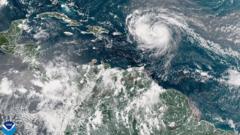Hurricane Erin has rapidly intensified overnight, escalating to a powerful category five storm with maximum sustained winds clocking in at 160 mph (260 km/h). National Hurricane Center Director Mike Brennan characterized Erin as "extremely powerful," noting the storm's explosive transformation from tropical storm strength just days ago. The hurricane is projected to travel north of the Leeward Islands, the Virgin Islands, and Puerto Rico over the weekend, where it may deliver heavy rains amounting to 6 inches (15 cm) that could cause flash flooding and mudslides.
The storm marks the first hurricane of the 2025 Atlantic season and is not currently anticipated to reach the mainland of the United States. The process of rapid intensification, defined as an increase in wind speed of at least 34 mph within a single day, was evident as Erin's winds escalated from 100 mph on Saturday morning to a staggering 160 mph, according to Mr. Brennan.
Next week, Erin is expected to shift gradually northward, passing east of the Bahamas and moving toward the Outer Banks of North Carolina. The hurricane is likely to produce life-threatening surf and rip currents along nearly the entire East Coast of the United States, with Florida and mid-Atlantic states facing the gravest surf conditions. Furthermore, Bermuda may also experience perilous surf and significant rainfall, as indicated by Mr. Brennan.
Due to strong gale force winds, the US Coast Guard has enacted restrictions for vessels in ports on St. Thomas and St. John in the US Virgin Islands, as well as in six municipalities in Puerto Rico, including San Juan. The National Oceanic and Atmospheric Administration (NOAA) has warned of an "above normal" Atlantic hurricane season this year, attributing the anticipated increase in category four and five tropical storms to climate change.




















